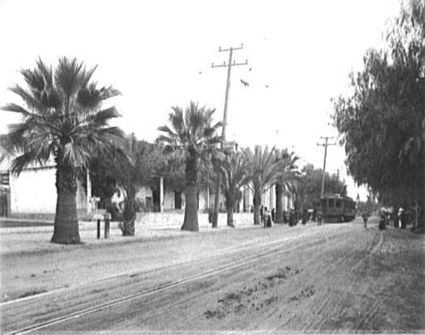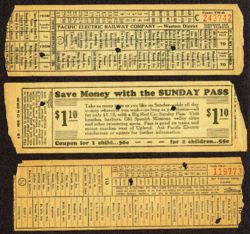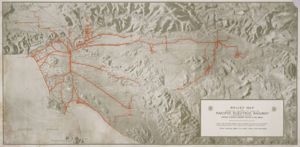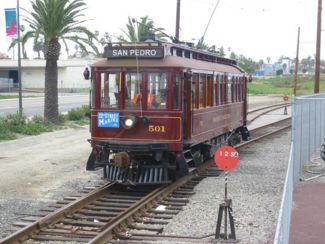Pacific Electric Railway
| Pacific Electric Railway | |
|---|---|
| logo | |
| Reporting marks | PE |
| Locale | Los Angeles, California, and its suburbs |
| Dates of operation | 1901 – 1961 |
| Track gauge | 4 ft 8½ in (1435 mm) (standard gauge) |
| Headquarters | Los Angeles, CA |
The Pacific Electric Railway (AAR reporting marks PE), also known as the Red Car system, was a mass transit system in Southern California using streetcars, light rail and buses. At its greatest extent, around 1925, the system connected cities in Los Angeles and Orange Counties, and to Riverside County and San Bernardino County in the Inland Empire.
The system was divided into three districts:
- Northern District: Pasadena, San Gabriel Valley, San Bernardino.
- Southern District: Long Beach, Newport, San Pedro, Santa Ana.
- Western District: Hollywood, Burbank/Glendale, San Fernando Valley, Santa Monica.
Originally, there was an Eastern District, but this was incorporated into the Northern District early in the company's existence.
Contents
Origins
The Pasadena and Pacific railroad was an 1895 merger between the Pasadena and Los Angeles and the Los Angeles and Pacific. It boosted tourism by living up to its motto "from the mountains to the sea."
During this time, the Pacific Electric Railway was established by railroad and real estate tycoon Henry Huntington in 1901. Henry's uncle, Collis P. Huntington, was one of the founders of the Southern Pacific Railroad and had bequeathed Henry a huge fortune upon his death. Only a few years after the company's formation, most of Pacific Electric's stock was purchased by the Southern Pacific Railroad, which Henry Huntington had tried and failed to gain control of a decade earlier. In 1911, Southern Pacific bought out Huntington completely and also purchased several other passenger railway operators in the Los Angeles area including Pasadena and Pacific, resulting in the "Great Merger" of 1911. At this point the Pacific Electric became the largest operator of interurban electric railway passenger service in the world, with over 1,000 miles of track. The Pacific Electric also ran frequent freight trains under electric power throughout its service area, including one of the few electrically-powered Railway Post Office routes in the country. The PE was also responsible for an innovation in grade crossing safety that was quickly adopted by other railroads, a fully automatic electromechanical grade crossing signal nicknamed the "wigwag."
After the Great Merger, Henry Huntington purchased the company which provided local streetcar service in central Los Angeles and nearby communities, the Los Angeles Railway (LARy). These trolleys were known as the "Yellow Cars," and actually carried more passengers than the PE's "Red Cars" since they ran in the most densely populated portion of Los Angeles.
Decline of the Red Cars
Throughout their existence, the Pacific Electric and its predecessor railroads frequently lost money on passenger operations. There were few years when the company's income statement showed a profit, most notably during World War II, when gasoline was rationed and automobiles were not manufactured. Huntington's involvement with urban rail was intimately tied to his real estate development operations. In the pre-automobile era, electric interurban rail was the only way to connect outlying suburban and exurban parcels to central cities, and residential development of these was so lucrative that Huntington and Southern Pacific could use the Red Car as a loss leader. However, most of the company's holdings had been developed by 1920. As the company's major income source began to deplete, profitability required that the least-used Red Car lines be converted to cheaper buses as early as 1925. Those lines that had enough ridership to remain profitable began to suffer from traffic congestion.
Although the railway owned extensive private rights-of-way, usually between urban areas, much of the Pacific Electric trackage in urban areas was in streets shared with automobiles and trucks, and virtually all street crossings were at-grade, and increasing automobile traffic led to decreasing Red Car speeds on much of its trackage. At its nadir, the busy Santa Monica Boulevard line, which connected Santa Monica and Hollywood, had an average speed of 13 miles per hour, similar to the average speed today on Los Angeles area freeways. The company carried increased passenger loads during World War II, when Los Angeles County's population nearly doubled as war industries concentrated in the region and attracted millions of workers. Aware that most new arrivals planned to stay in the region after the war, local governments agreed that a massive infrastructure improvement program was necessary. At that time the public demanded, and politicians agreed to construct, a web of freeways across the region. This was seen as a better solution than a new mass transit system or an upgrade of the Pacific Electric, and large-scale destruction of neighborhoods for freeway construction began in 1951.
Dismantling and Rebirth
Pacific Electric passenger service was sold off in 1953 to a company known as Metropolitan Coach Lines, whose intention was to convert all rail service to bus service as quickly as possible. Many of the Pacific Electric passenger lines were shut down in 1954, but the California state government would not allow the most popular lines to be discontinued. In 1958, Metropolitan Coach Lines relinquished control of the remaining rail lines to a government agency, the Metropolitan Transportation Authority, which also took over the remaining streetcar lines of the successor of the Los Angeles Railway, the Los Angeles Transit Lines. Only a handful of electric train lines remained operating at that time and the conventional wisdom held that their days were numbered. The last passenger line of the Pacific Electric, the line from Los Angeles to Long Beach, continued until April 9, 1961. With the closure of the Long Beach line, the final link in the system as well as the PE's first line some sixty years prior, was eliminated. The PE's freight service was continued by the Southern Pacific Railroad and operated under the Pacific Electric name through 1964. The few remaining former Los Angeles Railway streetcar lines were removed in 1963. The majority of the surviving Pacific Electric rolling stock can be seen and ridden at the Orange Empire Railway Museum in Perris.
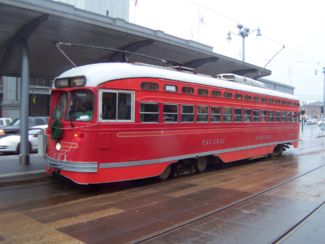
The "General Motors conspiracy"
The end of the Red Cars has been tied by some to the alleged General Motors streetcar conspiracy, in which a consortium of General Motors, Standard Oil, and others formed a front company, National City Lines, in order to buy streetcar lines, shut them down, and replace them with buses. The plot of the movie Who Framed Roger Rabbit is loosely based on this theory. While the overwhelming body of evidence shows that National City Lines did perform such actions, many other factors also contributed to the decline of electric traction in the United States, including rising real estate values, federal regulations that power utilities could not own trolley systems, and the inability of traction lines to modernize their aging equipment and rolling stock due to low revenues. Pacific Electric was operating buses as early as the 1920s, and began removing streetcar lines as early as the early 1930's.
Electric rail revival
Throughout the Pacific Electric's history, a variety of improvements in service or new systems were proposed, including subway trains and monorails. Political and business will transformed the Los Angeles megalopolis to one based primarily on automotive transit, paved with hundreds of miles of superhighways. Few lamented the decline and disappearance of rail-based mass transit in Los Angeles.
Beginning in the 1970s, a variety of factors, including environmental concerns, an increasing population and the price of gasoline led to calls for mass transit other than buses. After decades, the wheels of government began to move forward, and construction began on the Los Angeles County Metro Rail system in 1985.
In 1990, electric rail passenger train service once again returned to Los Angeles with the opening of the Blue Line. This line runs from downtown Los Angeles to Long Beach, using much of the same right of way as the original Pacific Electric line that was discontinued in 1961. Since then, the Los Angeles County Metropolitan Transportation Authority has opened more lines. The subway Red Line opened in three parts, connecting North Hollywood to Union Station in central Los Angeles. In 1995, the Green Line opened, running in the median of Interstate 105. The latest light rail line is the mostly at-grade Gold Line, connecting Pasadena to downtown Los Angeles along former Atchison, Topeka and Santa Fe Railroad (ATSF) trackage, including a historic 1895 railroad bridge across the Arroyo Seco.
On July 19, 2003, a 1.5 mile streetcar line connecting the cruise ship terminal with other attractions along the San Pedro waterfront began operation. This currently functions as a tourist attraction. Two newly constructed Red Car replicas provide service along the line. In addition, a restored 1907-vintage Pacific Electric car is available for special operations. This was financed and constructed by the Port of Los Angeles as part of its waterfront revival effort. There are plans to extend this line approximately two more miles to the Cabrillo Aquarium. Trackage is in place, but funding for additional improvements has not been identified at this time. Some transit advocates have proposed linking this line to the Blue Line in Long Beach, but this would be a much more intensive and expensive project.
More rail lines are in the planning and building stages. In 2009, the Gold Line Eastside Extension will connect East Los Angeles to Downtown. If construction funds are identified, the "Foothill Extension" of the Gold Line will extend the service to Montclair, or possibly all the way to LA-Ontario International Airport by 2015.
There are several proposals for connecting the congested West Los Angeles area with rail service. The LACMTA will construct the Expo Line, a light-rail line. A color has not yet been assigned to this line. The LACMTA has announced that money is available for construction, which has begun, with surveying activities beginning in May 2006, and construction commencing in October 2006. Service is scheduled to begin as far as Culver City in 2010.
Other groups are lobbying to extend the renamed Purple Line to the west on Wilshire Boulevard, the city's most densely populated corridor, as was originally planned in mass transit plans designed as early as the late 1960s. In 2005, Mayor Antonio Villaraigosa made as one of his most publicized campaign promises a pledge to set the wheels in motion for eventual construction of the "Subway to the Sea" as he called it.
It is unlikely that the Metro Rail system (without including the hundreds of miles of Metrolink commuter line track) will ever have as much track as the Pacific Electric, with increasing construction costs and the complexity of environmental regulations. Mass transit advocates have heralded as necessary and successful whatever rail trackage has been rebuilt. If all current proposals are built, by 2015 Los Angeles will have the third highest amount of mass transit track mileage in the United States, after New York and Chicago.
See also
- General Motors streetcar conspiracy
- Los Angeles Railway
- National City Lines
- San Diego Electric Railway
Further reading
- Bottles, Scott (1991). Los Angeles and the Automobile: The Making of the Modern City. University of California Press. ISBN 0-520-07395-9.
- Crump, Spencer (1977). Ride the big red cars: How trolleys helped build southern California. Trans-Anglo Books. ISBN 0-87046-047-1.
- Thompson, Gregory Lee (1993). The Passenger Train in the Motor Age: California's Rail and Bus Industries, 1910–1941. Ohio State University Press, Columbus, OH. ISBN 0-8142-0609-3.
External links
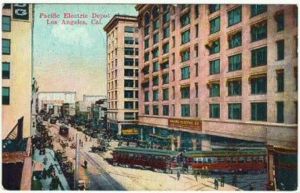
- Bill Volkmer's collection of Red Car Photos and post cards
- Corralitas Red Car Property
- Electric Railway Historical Association of Southern California
- Orange Empire Railway Museum official website
- L.A. Port waterfront Red Car line
- Pacific Electric Photos by Jim Stubchaer
- Pacific Electric Railway Monument
- Pacific Electric Subway
- Pacific Electric System Map 1949
- Proposal to bring the Red Car back to Downtown Los Angeles
- The Red Cars of Los Angeles
- Subway Tunnel Aerial Maps
- Tours in a Bygone Era
- Mapping Los Angeles' Electric Railways
